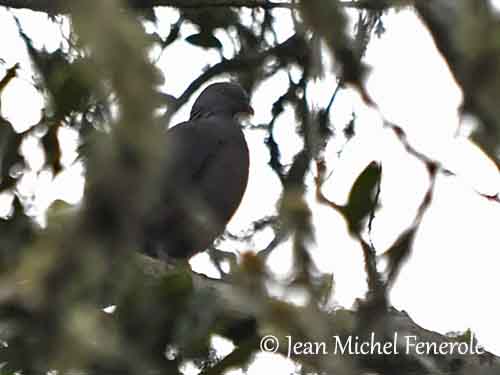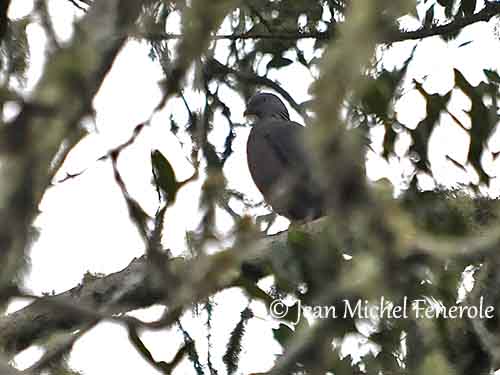
Fr: Pigeon de Bolle
All: Bolles Lorbeertaube
Esp: Paloma Turqué
Ita: Colomba di Bolle
Nd: Bolles Laurierduif
Sd: Kanarieduva
Photographer:
Jean Michel Fenerole
Photos d’Oiseaux du monde
Text by Nicole Bouglouan
Sources:
HANDBOOK OF THE BIRDS OF THE WORLD vol 4 by Josep del Hoyo-Andrew Elliott-Jordi Sargatal - Lynx Edicions - ISBN: 8487334229
PIGEONS AND DOVES by David Gibbs, Eustace Barnes and John Cox - Pica Press Sussex - ISBN: 1873403607
BirdLife International (BirdLife International)
Wikipedia, the free encyclopaedia
Bolle’s Pigeon
Columba bollii
Columbiformes Order – Columbidae Family
INTRODUCTION:
The Bolle’s Pigeon is endemic to the Canary Islands and resident in some islands of the archipelago.
Very similar to the Laurel Pigeon, it was distinguished from the latter by the German naturalist Carl August Bolle. The name of this species pays tribute to him.
DESCRIPTION OF THE BIRD:
Biometrics:
Length: 35-37 cm
Wingspan: 65-68 cm
The adult has uniform dark blue-grey upperparts with plain wings. The flight feathers are blackish. We can see a broad, pale grey, subterminal band across the black tail.
The underparts are uniform dark grey with purplish to maroon breast. The pale grey band is well visible on the underside of the tail.
There is green or pink iridescent area on the hindneck.
The bill is red with white cere. The eyes are pale yellow, surrounded by red eyering. Legs and feet are red.
Both sexes are similar.
The juvenile is duller, mostly sepia-brown on the upperparts, with paler edges on scapulars and wing-coverts. The underparts are rufous-brown. The plumage lacks iridescence. The bill is blackish. Legs and feet are brownish-red.
RANGE:
The Bolle’s Pigeon is present on La Palma, Gomera, Tenerife and El Hierro in the Canary Islands. It was formerly on Gran Canaria too.

HABITAT:
The Bolle’s Pigeon frequents mainly the remaining laurel forest with species such as Lauraceae, Ericaceae and Rosaceae in mountainous areas and ravines.
It is also present in heath and sometimes in open cultivated areas. It is found mainly between 1300 and 1500 metres of elevation on Tenerife, but also lower, around 600 metres.
CALLS AND SONGS: SOUNDS BY XENO-CANTO
The Bolle’s Pigeon gives short “tru-tru-tru-tru-tru” as territorial call, sometimes repeated 2-3 times. This call can become longer as advertising call. It usually utters mournful crooning “pu-pu-pooo”.
BEHAVIOUR IN THE WILD:
The Bolle’s Pigeon feeds primarily on fruits and berries according to the timing on fruiting of the different plants and tree species. It also feeds on a variety of plant matter such as leaves, shoots, leaf and flower buds. It may supplement this diet with small invertebrates.
They can feed in flocks of up to 50 birds, both in trees where they pluck berries and on the ground, including in crops when berries are lacking.
During the breeding season, they are territorial and perform some typical displays with shallow, repeated glides with loud wing-clapping, ending in a long circular glide to a perch. The courtship displays include the typical series of deep bows, accompanied by cooing.
The Bolle’s Pigeon is sedentary and only moves to lower elevation in late summer to feed on fruit and cereal crops in cultivated fields. Some movement between islands probably occurs.
The flight is powerful, rapid and direct, with regular wingbeats.

REPRODUCTION OF THIS SPECIES:
The breeding season takes place between January and September, but this species may breed throughout most of the year, with peak in February/May. They can produce 2-3 broods per year.
The typical Columbidae nest is flimsy, made with twigs, and placed in tree, between 2 and 15 metres above the ground, usually 6-8 metres. The trees are mainly Erica arbore and Erica scoporia in gallery forest or on steeper slopes.
The female lays a single white egg. The incubation lasts 18-19 days. The chick fledges about 30-35 days after hatching, but it depends on parents for food for some weeks after fledging.
The nests are often attacked by the Black rats (Rattus rattus) on Tenerife. The young birds are sometimes preyed upon by the Eurasian Sparrowhawk.
PROTECTION / THREATS / STATUS:
The Bolle’s Pigeon is not globally threatened with an increasing population. It has restricted range but numbers appear stable with an estimation equivalent to 3,300/13,000 mature individuals.
However, forest loss and fragmentation, illegal hunting, predation by introduced mammals, grazing pressure from sheep and avian diseases are still potential threats.